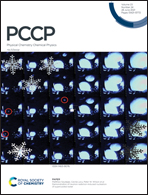Ultraviolet photodissociation dynamics of PCl3 at 235 nm: three-dimensional ion imaging and theoretical analysis
Abstract
The photodissociation dynamics of PCl3 at 235 nm has been studied by monitoring ground state Cl(2P3/2) and spin–orbitally excited Cl(2P1/2) atoms by resonance enhanced multiphoton ionization (REMPI). Also, the PCln+ (n = 0, 1, 2) photoions were observed non-resonantly. The speed distributions and speed-dependent anisotropy parameters β for all these particles have been determined by three-dimensional photofragment ion imaging. The β parameters are close to zero for all these particles. The relative yield of excited Cl(2P1/2) atoms for photodissociation of PCl3 is 0.49 ± 0.03. The speed distributions of Cl(2P3/2) and Cl(2P1/2) atoms are bimodal, mainly resulting from the sequential photodissociation PCl3 → PCl2 → PCl. Near-resonant two-photon ionisation followed by near-resonance one-photon photodissociation is proposed for the production of PCln+ photoions. Using Condon's reflection principle, we constructed the vibrational mode dependent absorption spectrum by accounting for the vibrational motion for all six normal coordinates. As a result, the absorption of 235 nm radiation by PCl3 occurs due to zero vibrational motion rather far from the equilibrium geometry. In particular, movement along the Q2 normal coordinate results in an efficient photoinduced transition into the excited state à of D3h symmetry due to a parallel transition.



 Please wait while we load your content...
Please wait while we load your content...